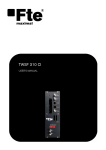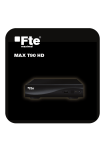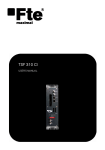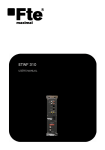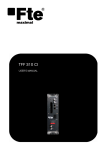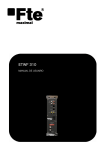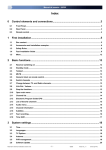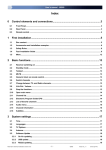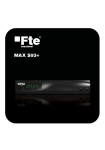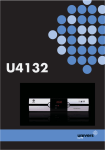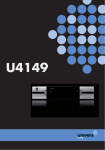Download User Manual - Fte maximal
Transcript
MAX S123 HD SAFETY PRECAUTION The lightning flash with arrowhead symbol, within an equilateral triangle, is intended to alert the user to “dangerous voltage” and to prevent from a risk of electric shock. WARNING: To reduce the risk of electric shock, don’t open the cabinet. Refer servicing to qualified personnel only. Warning: -The apparatus shall not be exposed to dripping or splashing and that no objects filled with liquids, such as vases, shall be placed on the apparatus. - Do not place naked flame sources, such as lighted candles on the apparatus; otherwise, there is the danger of fire. - The unit should be connected to a power supply only of the type described in the operating instructions or as marked on the unit. If you are not sure of the type of power supply (for example: 120 or 230V) to your home, consult your local dealer or local power company. - Do not open the cabinet or touch any parts in the inner mechanism. Consult your local dealer for technical service if the opening is required. - The mains plug is used as the disconnect device, the disconnect device shall remain readily operable. - Take attention to the environmental aspects of battery disposal. The battery of remote control should not be exposed excessive heat such as sunshine, fire or the like. - Maintenance man must use the appointed screw in the rear plate. - Ensure a minimum distance of 5 cm around the apparatus for sufficient ventilation. - Ensure that the ventilation is not impeded by covering the ventilation openings with items such as newspapers, table-cloths, curtains, etc. - Use the apparatus only in moderate climates (not in tropical climates). - Do not open the cabinet to avoid the unit direct exposure to radiation. Unit Cleaning: After the unit power is turned off, you can clean the cabinet, panel and remote control with a soft cloth lightly moistened with a mild detergent solution. Attachments: Never add any attachments and/or equipment without the manufacturer consent; as such additions may result in the risk of fire, electric shock or other personal injury. Locating: Slots and openings in the cabinet are provided for ventilation to protect it from overheating. Do not block these openings or allow them to be blocked by placing the STB on a bed, sofa or other similar surface, nor should it be placed over a radiator or heat register. Power-Cord Protection: Place the power-supply cord out of the way, where it will not be walked on. Please take special attentions to cords at plugs, convenience receptacles and the point where they exit from the unit. Object and Liquid Entry: Never put objects of any kind into this STB through openings, as they may touch dangerous voltage points or short-out parts that could result in a fire or electric shock. Never spill any liquid on the STB. Note: Moisture may be formed inside the unit in the following conditions: When the unit is suddenly moved from a cold environment or an air-condition room to a warm place. Immediately after a heater has been turned on. In a steamy or very humid room. If the moisture forms inside the unit, it may not operate properly. To correct this problem, turn on the power and wait about two hours for the moisture to evaporate. Parts Replacement: When the unit parts need to be replaced, user should make sure the service technician use the replacement parts specified by the manufacturer or having the same characteristics as the original part. Unauthorized replacement may put the unit in the risk of fire, electric shock or other hazards. Safety Check: After all the maintenances and repairs are done, user is required to request the service technician to conduct the overall safety check to ensure the machine is in the proper condition. rev 1.1 ENGLISH The exclamation point within an equilateral triangle is intended to alert the user to important operating and maintenance (servicing). Danger of explosion if battery is incorrectly replaced. Replace only with the same or equivalent type. PAG. 2 QUICK INSTALLATION GUIDE In order to download the complete user’s guide and get more information about receivers, please visit the website http://www.ftemaximal.com QUICK INSTALLATION GUIDE Follow next steps for the correct installation of this receiver. STEP 1: OUTPUT VIDEO CONFIGURATION In order to correctly visualise the reception signal on TV, you must configure the format and mode of the video output. - Output format. You will be able to select among the following formats: 1.In case SD video output is selected, you will be able to select AUTO, PAL or NTSC format. 2.In case HD video output is selected, you will be able to select among the following formats: AUTO, TV, 480I, 480P, 576I, 576P, 720P_50, 720P_60, 1080I_25, 1080I_30, 1080P_50, 1080P_60, 1080P_25, 1080P_30 or 1080P_24. STEP 2: CONNECTIONS rev 1.1 The coaxial cable, with satellite signal, must be connected to the “IF IN” connector. The “HDMI” or SCART connector must be connected to the TV set. Screw the WiFi antenna on the USB adapter. Make sure it is well screwed as far as it will go, to not lose sensitivity. Connect the WiFi Dongle in the “USB” port in order be able to open the internet menu. Turn the WiFi antenna orientating it vertically upwards. Depending on the type of installation, the receiver should be connected and configured following next examples. Example 1 – Basic System Example 2 – DISEqC switches PAG. 3 ENGLISH - Video output mode: In order to get a correct visualization of the image we recommend: 1. In case you make the connection to your Tv by the means of “Tv scart” output, select “SD” video output 2. In case you make the connection to your Tv by the means of “HDMI” output, select “HD” video output. Example 3 – Combined with terrestrial Example 4 – Dongle wifi connection STEP 3: BASIC CONFIGURATION OF THE RECEIVER IMAGE 1 The receiver includes an installation assistant (Quick Setup) that will help you to setup the different parameters. When the receiver is turned on at first time, the next menu is shown on the TV (Image 1): The receiver is programmed with all the channels of Astra (at position 1 of the DISEqC), Hotbird (at position 2 of the DISEqC), Hispasat (at position 3 of the DISEqC) and Turksat (at position 4 of the DISEqC). If your installation is different to this case, please follow installation steps to search the channels. In order to move through the different options of this menu, ] of your remote control. If a “Short please use the keys [ circuit on the LNB” message is shown on the TV, please check the connections before continuing the installation. Menu Language: press [ ] to select languages. The selection of languages include: English, German, French, Spanish, Italian, Portuguese, Turkish, Russian, Polish, Dutch, Arabic and Farsi. First Audio: Some channels offer more than one audio language. This function allows you to set the preferred audio language for ]. If a channel offers the same those channels using [ audio language as the “First Audio” you set the system will play this audio language as default. If the channel does not offer this audio language then the system will compare the offered languages with the second audio language. The selections of audio languages include: English, German, French, Spanish, Italian, Portuguese, Turkish, Russian, Polish, Dutch, Arabic and Farsi. rev 1.1 ENGLISH QUICK INSTALLATION GUIDE PAG. 4 QUICK INSTALLATION GUIDE Second Audio: If the channel has no audio language that corresponds with “First Audio” but with “Second Audio” the system will play the second audio language as default. If no audio language corresponds with the “Second Audio” then the default language of the current channel will be played instead. The selections of audio languages include: English, German, French, Spanish, Italian, Portuguese, Turkish, Russian, Polish, Dutch, Arabic and Farsi. rev 1.1 IMAGE 2 IMAGE 3 Single search: You can edit the following items (Image 2): ] to switch Satellites or press [OK] to 1. Satellite: Press [ enter satellite list to select directly. ] to switch the options of 2. DiSEqC1.0 4Port: Use [ DiSEqC switches. ] to select the desired 3. On “TP Index” item use [ transponder. to select to scan only 4. In the “FTA Only” item, press [ free channels or even scrambled channels. If you select “Yes” it will scan free channels only. ] to select to scan TV 5. In “Scan Channel” item, press [ + Radio Channels, or just TV channels or just Radio channels. 6. In “Scan Mode” item you can select “Auto Scan” to blind scan, “Preset Scan” to scan all preset transponders or NIT search. 7. Move the highlight to “Search” and press [OK] button to start scanning. Bars are showing the progress of the channel scanning in the lower part of the window and the found channels are listed. You can stop the scan with [Exit] and save the so far found channels. 8. Press [Exit] to exit this menu. A window to confirm the changes will appear. Multi search: You can edit the following items (Image 3): 1. On “FTA Only” item, press [ ] to select scanning of all channels or just scanning of free channels. If you select “Yes” it will scan free channels only. 2. On “Scan Channel” item, press [ ] to select the scanning range from TV + Radio Channels, only TV channels or only Radio channels. PAG. 5 ENGLISH LNB Power: Here you can set the power output to the LNB. If your receiver is connected to the LNB directly then you need to set the LNB Power to “On”. If your receiver is connected to a multi switch (SMATV signal distribution system) then it may be that you don’t need to provide the power to the LNB. But since this is depending on the kind of installed distribution system we recommend you to contact your installer or to refer to the user manual of this system to get the correct information. QUICK INSTALLATION GUIDE 3. On “Scan Mode” item, you can select “Auto Scan” to make a blind scan, “Preset Scan” to scan all preset transponders of the selected satellites or NIT search. 4. Select “Search” and press [OK] to start scanning. In the lower part of the window the progress of scanning and the found channels are displayed. 5. Press [Exit] to cancel or finish the scanning and saving the found channels. Main Menu: Selecting this option, the main menu will appear ENGLISH on the TV. STEP 4: TIME CONFIGURATION It is recommended to setup the clock before starting to enjoy the receiver, because correct time maybe is required by some applications. Please complete following options: NOTE: If the current channel provides the correct time information, you will see the current time after you entered “Time” menu. If the channel doesn’t provide time information, you have to input the date and time information manually. The most channels support the time signal. ] to switch on/off this option. When 5. Time display: Use [ the option is enabled, the time will be displayed at the TV in a frame in the top right margin. 6. Press [Exit] to exit the menu. rev 1.1 IMAGE 4 Press the [Menu] key of the remote control for appearing the main menu. Select the “System Setup” option and confirm pressing [OK]. Once in the “System Setup” option, please select “Local Time setting” option and press [OK]. Select “Time” option and press [OK]. Image 5 is watched on the TV. For setting up the time, please complete: 1. GMT Usage: this option will allow you to select if the date and time will be introduced manually (GMT Usage: Off) or if you wish to introduce the offset respect GMT manually (GMT Usage: On). 2. GMT Offset: If GMT Usage is On, the offset respect GMT has to be configured depending on your region or country. Use ] keys to choose the offset. Remember that the the [ offset values are between -12:00 and +12:00 3. Summer time: this option is only available when “USE GMT” is enabled. Use [ ] to switch on/off the summer timetable. 4. Date / Time: In order to introduce manually the time and date. Before these values can be modified, the automatic control of GMT has to be turned off. PAG. 6 QUICK INSTALLATION GUIDE STEP 5: INTERNET CONFIGURATION IMAGE 5 2. Go to the “Internet” menu again, select “TCP/IP Setting” option and press [OK]. IMAGE 7 is watched on the TV. ] keys to switch between “On” (All settings - DHCP: Use [ will be configured automatically by the network) or “Off” (All network settings in this window must be configured manually). - Select “Apply” option and press [OK] to save changes. rev 1.1 IMAGE 7 PAG. 7 ENGLISH IMAGE 6 Press the [Menu] key of the remote control for appearing the main menu. Select the “Internet” option and confirm pressing [OK]. 1. Once in the “Internet” menu, please select “WiFi manager” option and press [OK]. IMAGE 5 is watched on the TV. Now the receiver searches for WiFi connections and shows the available wireless networks. - Pressing [Red] button the list is refreshed. ] to select the network you want to - Use the keys [ connect and press [OK] button. A new window will appear (IMAGE 6). - If your WiFi network is encrypted, enter the password pressing [Ok] on the “Key” option. A new window will appear to enter the key. Once you have writed the password press [Blue] button to save it. - Select “Connect” option and press [OK] to start the connection to network, or select “Cancel” option and press [OK] to abort. QUICK INSTALLATION GUIDE TV Channel List: This option shows the list of TV stored channels. Radio Channel List: This option shows the list of Radio stored channels. Channel Setup: This option allows setting the receiver to start in a predefined channel. Favourite Channel List Name: It allows changing the name of the favourite groups. Antenna connection: It allows choosing the type of installed antenna, between fixed, motorized and Unicable. Antenna Setup: It allows to configure Antenna parameters. Satellite List: This option shows all the stored satellites. This list can be modified. TP List: This option shows all the stored TP. This list can be modified. Single Satellite Search: This option allows search for the channels of one satellite. Multi Satellite Search: This option allows search for the channels of various satellites. TP Scan: This option allows search for the channels of one TP. Satellite Guide: After introducing some data, this application allows to know which orientation and elevation should be the antenna. Language: This option allows choosing the language of the menus. TV System: This option allows choosing the video Standard and other parameters of the screen. Time & Timer Setting: Timer setting menu. OSD Setting: This option allows configuring the subtitles of the channel information. Parental Lock: In this option, user can lock the access to the menu and change the password of the receiver. rev 1.1 ENGLISH Delete All: This option deletes all TV and Radio stored channels. Power setting: Activate or deactivate the automatic Standby option after 3 hours, turns on or off the LNB power or enable / disable Low Power Consumption mode. PAG. 8 QUICK INSTALLATION GUIDE Information: Shows all the technical information for the selected channel. Quick Setup: The installation assistant will be loaded. Factory Setting: This option resets the receiver and loads the factory default values. Software Upgrade: For updating your receiver through USB or satellite (OTA) and also for making backup of the information of the receiver in a USB device. Media List: Multimedia Player. Disk Information: You can see the capacity of the hard disk. TCP/IP Setting: Allows to configure IP settings. WiFi Manager: Allows to select the WiFi network from a list. Weather: Weather information. Internet radio: For listening to the Internet radio. FTE radio: List of German radio stations. Internet video: For playing some internet videos. Flickr: For displaying internet images. rev 1.1 NOTE: In the area of Internet video, there is offered some Adult content. This area is specially secure. Please change the default password in the Parental Lock menu of the System Setup menu. PAG. 9 ENGLISH Remove USB device safely: Allows remove USB device of safety way. INDEX 2. Basic Operations 2.1. Standby ……………………..............................................………………………15 2.2. TXT …………..................................................……………………………………..15 2.3. Mute……………............................................………………………………………..15 2.4. Channel Number…………...........................……………………………………………………15 2.5. CH + / CH -…...............................................…………………….…………………………..16 2.6. TV/RADIO…………........................…………………………………………………….16 2.7. Vol+/Vol-…......................................……………………………………………………….16 2.8. Exit….................................……………………………………………………..16 2.9. Menu……………………...................................…………………………………..16 2.10. Recall…..............................................………………………………………...16 2.11. Channel List…………………….........................…………………………………...16 2.12. EPG…………………...............................…………………………………………...16 2.13. Favourites………....................................………………………………………………...17 2.14. Audio Track / Mode…...........................……………………………………………….17 2.15. Information……..................................…………………………………………...17 2.16. ZOOM………………………………….............…………………………………...17 2.17. Subtitles……………………………….............……………………………………...17 2.18. LNB Short………………………….......…………………………………………...18 2.19. USB............………………………….......…………………………………………...18 3. Channel 3.1. TV Channel List…………....................……………………………………………..19 3.1.1. Favourite………...............................………………………………….……………19 3.1.2. Move.……………..........................……………………………………….…………19 3.1.3. Sort......................................………………………… …………………….………..20 3.1.4. Edit….......................................…………………………………………….20 3.1.4.1 Delete…........................................…………….…...20 3.1.4.2 Skip….......................…………………………………..…………..20 3.1.4.3 Lock..….................................………………………… …….……….20 3.1.4.4 Rename..........................…………………...………………………...21 3.1.5. Find…………….........................……………………..……..………………..…….21 3.2. Radio Channel List……..................................……………………………………......21 3.3 Channel Setup…………..................................………………………………......21 3.3.1. Start-up Channel……………................................……………………………......21 3.3.2. Channel Play Type………........................…………………………………......21 3.4. Favourite List Name……..........….......................………………………………......22 3.5. Delete All…….....................…………...............…………………………………….22 rev 1.1 ENGLISH 1. Panel & Remote Control Description 1.1. Front Panel Description…….......................................…………………………13 1.2. Rear Panel Description……................................………….…………………..13 1.3. Remote Control Description…...............................................…………………………..14 PAG. 10 INDEX 4. Installation 4.1. Antenna Connection…………......................……………………..…………………..23 4.2. Antenna Setup………...........................…………...………..…………………….23 4.3. Satellite List………….............................………………………...………………...24 4.4. TP List………….............................………………………...………………...25 4.5. Single Satellite Search…..................…………………………..………………...26 4.6. Multi Satellite Search…..................…………………………..………………...26 4.7. TP Scan………..………………................………………………..…………………...27 4.8. Satellite Guide…………..................…………………………..………………...27 6. Tools 6.1. Information…………………………...................................………………………….33 6.2. Quick Setup……….......………………………......................……………………...33 6.3. Factory Setting………………………………………..………………..............................33 6.4. Software Update………………………….………………………............................34 6.4.1. Upgrade by USB...................................................................34 6.4.2. Backup to USB ..........................................................................34 6.4.3. S/W Upgrade by OTA...................................................................35 6.4.4. Channel List Upgrade by OTA......................................................35 6.4.5. Upgrade by Network...................................................................35 6.5. Remove USB device safely………………………….…………............................35 rev 1.1 7. Media Management 7.1. Media List.............................................................................................36 7.1.1. Edit files and folders........................................…………..……………37 7.1.2. Audio player…………....………………...................………................37 7.1.3. Picture viewer..........................................................…………….37 7.1.4. Video player............................................................................37 7.2. Disk Information..............................................................................................37 PAG. 11 ENGLISH 5. System Setup 5.1. Language………………….............………………………...…………………...28 5.2. TV System……………..............…………………………..…………………...28 5.3. Time & Timer Setting ………....................………………………...………………29 5.3.1. Timer.......................................................................................29 5.3.2. Local Time setting........................................................................30 5.3.3. Sleep Timer................................................................................31 5.4. OSD Setting…………………………………..............................…………………...31 5.5. Parental Lock…………………………............................…………………………….31 5.6. Power setting……………………….............................……………………………..32 8. Internet 8.1. TCP/IP Setting.............................................................................................38 8.2. WiFi Manager.............................................................................................38 8.3. Weather..................................................................................................38 8.4. Internet radio.............................................................................................39 8.5. FTE radio....................................................................................................39 8.6. Internet video.............................................................................................40 8.7. Flickr.............................................................................................40 8.7.1. Date............................................................…………..……………40 8.7.2. Recent…………...........………………...................………................40 8.7.3. Tag search.................................................................…………….41 8.7.4. Search..................................................................................41 9. Technical Specification……………………………………........................................42 10. Conformity declaration……………………………………........................................43 rev 1.1 ENGLISH INDEX PAG. 12 PANEL & REMOTE CONTROL DESCRIPTION 1. PANEL & REMOTE CONTROL DESCRIPTION 1.1. FRONT PANEL DESCRIPTION 2 3 4 5 1. POWER / STANDBY LED: Switches the receiver on, or enters standby mode. / Shows if the receiver is in Standby mode (when LPC mode is ON). 2. CH+/CH-: Changes channels or controls the cursor in menus. 3. IR-SENSOR: Reception sensor for the IR remote control signals. 4. DISPLAY: 4 Digits to display the program numbers. 5. USB: Connector for external USB 2.0 HighSpeed devices or for Wifi Dongle. 1.2. REAR PANEL DESCRIPTION 1 rev 1.1 4 2 5 3 6 7 8 9 1. IR-SENSOR: External IR sensor. (Optional accessory, code SPX409) 2. COAXIAL S/PDIF: Coaxial output for digital audio (AC3). 3. VIDEO: Video output for external monitor, TFT or video beamer. 4. IF IN: Satellite input. Max. 300mA 5. IF OUT: Satellite output for cascading to other devices. Note: The operation of another receiver at the same time is only possible with limited channel selection. 6. AUDIO: Audio output for home audio systems. 7. TV SCART: Output SCART for the connection to a TV set. 8. HDMI: HDMI output for connecting to a TV. 9. DC IN: 12 VDC connection (power supply). PAG. 13 ENGLISH 1 PANEL & REMOTE CONTROL DESCRIPTION 1 2 3 5 4 9 8 13 12 6 7 10 11 14 15 16 17 18 19 20 21 22 24 23 26 25 27 28 29 1. POWER: Switches receiver ON or in stand-by-mode. 2. MUTE: Switches audio on and off. 3. Color Keys: Controls menu options. 4. ZOOM: Zoom function. 5. SUB: Switches subtitle on and off. 6. TIMESHIFT: Without function currently. 7. USB: Opens the multimedia process menu. 8. TV/R: Switches between TV and Radio channels. 9. TXT: Opens and closes teletext. 10. PVR LIST: Without function currently. 11. SLEEP: It opens the Sleep Timer menu. 12. PLAY: Start / Stop button for media files. 13. || (Pause): Pause button for media files. 14. STOP ■ : Stop button for media files. 15. REC : Without function currently. 16. MENU: Opens the main menu. 17. EXIT: Exit menus or stop operations. : Adjusts audio volume or controls the cursor in 18. menus. : Changes channels or controls the cursor in 19.menus. 20.- OK: Confirms selections or opens channel list. 21. EPG: Shows the EPG information. 22. INFO: Shows channel information with signal bar. 23. |<< / >>| : Jump back / Jump next. 24. AUDIO: Opens audio menu. 25. SAT: It shows the satellite list. 26. << / >>: Backward / Forward button for media files. 27. NUMERIC KEYS: For direct typing values and names. 28. FAV: Opens favourite channel list. 29. RECALL: Watch the last viewed channel. rev 1.1 ENGLISH 1.3. REMOTE CONTROL DESCRIPTION PAG. 14 BASIC OPERATIONS 2. BASIC OPERATIONS 2.1. STANDBY 1. Press [Power] button to switch from TV mode to Standby mode. 2. In Standby mode press [Power] button again to switch back to TV mode. The last active channel will be showed. 2.2. TTX 1. Press [TXT] button in TV mode to open the teletext page (OSD 1). This service is depending on the support of the channel provider. 2. If the channel does not support teletext information, it will show “No Teletext Data” on the screen. OSD 1 2.3. MUTE 1. Press the [Mute] button to mute the sound. On the screen an icon will be displayed to indicate the muted sound (OSD 2). 2. Press the [Mute] button again to restore the sound. rev 1.1 2.4. CHANNEL NUMBER OSD 2 In TV mode you can enter the channel number directly with your remote control unit and confirm the number with the OK button to change to the desired channel. PAG. 15 ENGLISH ? FREQUENTLY ASKED QUESTION Q: The power of my STB is on and it is running in TV mode but the TV screen shows nothing: A: Make sure the TV set has been set to the correct video input (not the TV channels). For example, if you have connected the STB to the Video1 input of the TV set, then you need to select the corresponding Input on the TV. Mostly it is done with the AV button of the TVs remote control unit. Q: My STB is running in TV mode but the TV screen shows nothing except one ball and “No Signal”. A: That means the channel you selected has no signal. This can be caused by several reasons: 1. The channel you selected is not from the satellite to which your dish is pointing. Select another channel. 2. The signal of current TV channel is too weak. You can try to change to other channels with a stronger signal. If the problems still exist, please consult your local dealer or installer for technical service. 3. You selected the wrong LNB type in the installation menu or your DiSEqC switch configuration is not correct. BASIC OPERATIONS 2.5. CH +/ CH In TV mode press [ ] to change channel. 2.6. TV/RADIO In TV mode, press [TV/R] to switch to Radio mode. In Radio mode press [TV/R] again to switch back to TV mode. 2.7. VOL+/VOL- OSD 3 ] to adjust volume. 2.8. EXIT Press [Exit] button to exit the current menu. 2.9. MENU Press [Menu] button to enter or exit the current menu. 2.10. RECALL Pressing the [Recall] button allows you to toggle between the actual and the last selected channel. 2.11. CHANNEL LIST OSD 4 OSD 5 OSD 6 In TV mode press [OK] button to open the Channel List window. Reduced Channel List (OSD 3): ] keys to navigate this list. You can use [ 1. Press [Yellow] button to open the SAT list. After selecting a satellite the channel list will be reduced to the channels of this satellite. 2. Press [Blue] button to open the “Find” window (OSD 4). You can use this feature to find channel by their names. 3. Once the desired channel is selected, press [OK[ to change and display the marked channel. 2.12. EPG 1. The STB supports Electronic Program Guides (EPG) to give you information about the actual programs of certain channels like event name, subtitle, description, start and finish time. This feature is depending on the service of the channel provider. Press [EPG] to open the EPG window (OSD 5). 2. Press the [INFO] button in the EPG menu to display the detailed information of the actual event in the selected channel (OSD 6). 3. With the [Red] button you can program a timer with the start and finish time and date of this event. (To program a recording, the event does not have to be started). rev 1.1 ENGLISH In TV mode, press [ PAG. 16 BASIC OPERATIONS 4. Press the [Yellow] button to show the EPG information in 24 hours time. 5. Press the [Green] button to show again the EPG information from the last 24 hours. 6. To close the EPG menu press [Exit]. 2.13. FAVOURITES ? FREQUENTLY ASKED QUESTION Q: Why the screen displays “No Favourite Channel” after pressing the [Favourite] button? A: No channels have been assigned to a Favourite Group yet. You can do this in the channel menu. OSD 8 2.14. AUDIO TRACK / MODE 1. In TV mode, press the [Audio] button to open the Audio Mode window (OSD 8). ] and change 2. Select the item you want to adjust with [ ]. the value with [ 3. Press [Exit] to leave this window. OSD 9 2.15. INFORMATION In TV mode, press [Info] button can open information screen (OSD 9), in the window shows the parameters of current channel. OSD 10 2.16. ZOOM 1. Press [Zoom] button in TV mode to zoom the image. Image can be augmented x16 times (OSD 10). 2. Press [Exit] to exit this function. rev 1.1 2.17. SUBTITLES OSD 11 1. In TV mode, press [Sub] button to open the Subtitle Mode window (OSD 11). ] and change 2. Select the item you want to adjust with [ ] depending on the provider information. the value with [ 3. Press [Exit] to leave this window. PAG. 17 ENGLISH OSD 7 1. In TV mode press the [FAV] button to display the Favourite Group window on the screen as the picture beside shows (OSD 7). ] you can select different Favourite Group. 2. With [ 3. In the Favourite Group window you can select the desired ] and confirm it with [OK] to favourite channel with [ ]. switch to it. In bigger groups you can navigate with [ 4. Press [Exit] to close the Favourite Group window. BASIC OPERATIONS 2.18. LNB SHORT When LNB is short, it will notify user on screen “LNB Short!” (OSD 12). Please check your cables and connections for shorts. When the short is removed the warning message will disappear. OSD 12 2.19. USB rev 1.1 ENGLISH It opens directly the Media management menu. PAG. 18 CHANNEL 3. CHANNEL OSD 13 3.1. TV CHANNEL LIST OSD 14 If you enter the Channel List menu a window like the one besides will open (OSD 15). ] and 1. You can move the highlighted channel with [ press [OK] to preview the highlighted program in the preview window. 2. Press [Pup/Pdw] on the RCU to jump between the channels by pages. ] to switch the Program Group. 3. Press [ 4. The colour buttons offer further functions to manage the channel list. 5. Press “Menu” to leave this menu. OSD 15 3.1.1. FAVOURITE OSD 16 1. Press [FAV] to open the Favourite window (OSD 16). ]. 2. You can select between 32 favourites groups with [ Press [OK] to assign the channel to a Favourite group. 3. Press [OK] again to remove the channel from the marked Favourite group. 4. Press [Exit] button to return to the TV Channel List. The channels of Favourites Groups are indicated with a favourite icon behind the name. 3.1.2. MOVE rev 1.1 To move channels: Pushing the [Red] button, you will see a picture like OSD 17. ]. Press - Move the channel to the desired position with [ [OK] to confirm the position. OSD 17 PAG. 19 ENGLISH Press [Menu] in the TV mode to enter the main menu (OSD 13). ] to select the Channel item. 1. Press [ 2. Press [OK] to enter the selected item. In the Channel menu (OSD 14): ] to select the wanted menu item. 3. Press [ 4. Press [OK] to enter the selected item among. - TV Channel List - Radio Channel List - Channel setup - Favourite channel list name - Delete All CHANNEL 3.1.3. SORT ENGLISH OSD 18 1. Press [Green] to open the Sort window (OSD 18). Press [ ] to select and [OK] to confirm your choice. 2. The ways of sorting are: - Name (A-Z): Sorting in Alphabetical Order, ignoring “$” symbol. - Name (Z-A): Sorting in Alphabetical Order, ignoring “$” symbol. - FTA: Sort channel by free and scrambled sequence. Free channels will be listed first and scrambled channels behind in the channel list. - Lock: Unlocked channels are listed first end locked channels at the end. 3.1.4. EDIT OSD 19 1. After pressing the [Yellow] button a window for entering the password will open. The default password is “0000”. 2. You can Delete, Skip, Lock and Edit the channel (OSD 19). 3. Press [Exit] to leave the Channel Editing. The system will ask you to confirm the saving of the changes you made. 3.1.4.1 DELETE OSD 20 In Channel Edit menu press [Red] button to mark a channel for deleting. A confirmation of deleting one or all channels from the list is displayed (OSD 20): - Please, confirm pushing the [Red] button to select the channels one by one. Only the selected channels will be deleted. - Confirm pushing the [green] button to select all the channels from the list. Marked channels (OSD 21) will be deleted after you confirm to save the changes when you leave this menu. 3.1.4.2 SKIP OSD 21 In Channel Edit menu, press [Green] button to place a Skip icon behind the name of the highlighted channel. Marked channels (OSD 22) will be skipped when you change channels in TV mode after you confirm to save the changes when you leave this menu. 3.1.4.3 LOCK rev 1.1 OSD 22 In Channel Edit menu, press [Yellow] button to place a Lock icon behind the name of the highlighted channel. Marked channels (OSD 23) will be locked and displayed only after password has been entered if you confirm to save the changes when you leave this menu. PAG. 20 CHANNEL 3.1.4.4 RENAME In “TV Channel List Edit” menu, pressing the [Blue] button you can enter edit box like below (OSD 24): After modification, move highlight to “OK” item and press [OK] key can save the modified value and exit “Edit” mode. Otherwise, press [Exit] key can exit “Edit” mode and won’t save any modification. OSD 23 1. Press [Blue] button to open the “Find” window like showed ] to select the leading besides (OSD 25). Press [ character of the channel name and press [OK] to confirm it. 2. After entering the character(s) highlight “OK” in the window and press [OK] on the RCU. 3. Press [Exit] button to close the Find window and brings you back to the channel list. 3.2. RADIO CHANNEL LIST Basically the operation of “Radio Channel List” is same as “TV Channel List”, except that in the small channel window the Univers Logo will be displayed (OSD 26). 3.3. CHANNEL SETUP When you enter the “Channel Setup” menu you will see a screen like (OSD 27): OSD 25 OSD 26 3.3.1. START-UP CHANNEL Press [OK] to enter “Start-up Channel” menu to see the screen like (OSD 28): 1. If you set of “Boot on Channel” to “On” you can edit the following two items. If the setting is “Off” the box always starts with the channel that was running when the box has been switched off. 2. On the “Mode” item you can select either “TV channel” or “Radio channel”. 3. On “Start-up Channel” item you can open the channel list by pressing [OK]. Then you can select the channel of you choice. Press [OK] again to confirm. rev 1.1 3.3.2. CHANNEL PLAY TYPE OSD 27 Press [OK] to enter “Channel Play Type” menu (OSD 29). 1. Here you can select the “playing channels” as “Free”, “Scrambled” or “All”. 2. If you select “Free” then all scrambled channels will be skipped when you change channels with [CH+/-]. 3. Press [Exit] to leave the “Channel Setup” menu. PAG. 21 ENGLISH OSD 24 3.1.5. FIND CHANNEL 3.4. FAVOURITE LIST NAME ENGLISH OSD 28 In this menu, user is able to change the name of the Favourite Groups. Press [OK] to enter this menu and you will see a screen like beside (OSD 30). To change the name of the Favourites Groups: ] and select a Favorite Group. 1. Press [ 2. Press [Ok] button to edit the name of the Group. 3. Once the name is correct, select “Ok” option and confirm pressing [OK] (OSD 31). 4. If the name is used by other group, an alert message will appear on the TV. 5. Select “Exit” and press [OK] to leave this menu. 3.5. DELETE ALL OSD 29 OSD 30 To delete all channels: 1. A safety question will show up where you have to confirm first (OSD 32). 3. Select “Yes” to delete all channels or “No” to cancel and confirm with [OK]. 4. Pressing [Exit] will exit the function directly without saving. ? FREQUENTLY ASKED QUESTION Q: IF I incautiously delete all channels, what should I do? A: There are three ways to restore: - To re-search all channels at the “Installation” menu. - Use “Factory Default” function to restore all channels in the “Tools” menu. The receiver will load the factory channels. - Using the option of the tool menu “updating software” “Backup USB”. rev 1.1 OSD 31 OSD 32 PAG. 22 INSTALLATION 4. INSTALLATION OSD 33 OSD 34 4.1. ANTENNA CONNECTION OSD 35 When you enter the “Antenna connection” menu you can see a window like the one beside (OSD 35). ] on the remote to select 1. LNB: Press the arrows [ the “Motor Antenna” option in case you have an installation with an engine *. If you do not have an engine, choose “Fixed Antenna”. If you have an Unicable installation choose “Unicable (SAT-CR)*. 2. Press [Exit] to exit this menu. * This receiver does not allow moving DiseqC motors 4.2. ANTENNA SETUP Depending on how the “Antenna Connexion” section is configured, it will allow configuring different parameters: rev 1.1 OSD 36 (Fixed Antenna) (OSD 36): ] to switch Satellites or press [OK] to - Satellite: Press [ enter satellite list to select directly. ] in order to change among - LNB frequency: Use [ “Universal”, a specific “Polarity and Band” or a specific frequency of the local oscillator. ] to select the desired - On “Transponder” item use [ transponder. ] to switch the options of DiSEqC - DiSEqC1.0: Use [ switches. - DiSEqC1.1: Use [ ] to switch the options of DiSEqC1.1 switches. ] to switch “ON” and “Off”. The 22 kHz - 22K: Use [ signal is used in KU Universal LNBs to change between low band and high band. After choosing LNB type “Universal” you PAG. 23 ENGLISH Press [Menu] in the TV mode to enter the main menu (OSD 33). ] to select the Installation item. 1. Press [ 2. Press [OK] to enter the selected item. In the Installation menu (OSD 34): 3. Press [ ] to select the wanted menu item. 4. Press [OK] to enter the selected item among. - Antenna connection - Antenna Setup - Satellite List - TP List - Single Satellite Search - Multi Satellite Search - TP Scan - Satellite Guide INSTALLATION cannot modify 22K. - Polarity: Press [ ENGLISH OSD 37 OSD 38 OSD 39 ] to switch between “Auto / H / V”. (Motorized Antenna *) (OSD 37): ] n order to change among “Universal” - LNB Freq: Use [ or a specific frequency of the local oscillator. - Motor Type: Press [ ] to select between DiSEqC1.2 and GOTO-X”. - Local Longitude: Geographic length of your position. - Local Latitude: Geographic latitude of your position. - Delete all: Deletes all the satellite positions saved. - Motor Setting: It allows configuring all the engine positions. - Limit Setup: It allows configuring the East and West position of the engine. * This receiver does not allow moving DiseqC motors (Unicable (SAT-CR)) (OSD 38): If you have an Unicable installation that allows you to distribute a satellite signal through a unique cable up to 8 receivers as maximum, in this menu option you can configure the receiver. ] to switch Satellites. (FIXED) - Satellite: Press [ ] to switch among “Unicable(9750- LNB Type: Press [ 10600” and “Unicable(10200)“ - IF Channel: Channel of the receiver if it belongs to an Unicable installation. Select with [ ] keys the numbers from 1 to 8. ] keys choose the frequency - Central Frequency: With [ of a channel in an Unicable system. ] to switch among “A” and “B“. - Sat Position: Press [ Each receiver of the Unicable system must have a channel and frequency different from the rest. - Press [Exit] to save the changes. 4.3. SATELLITE LIST OSD 41 rev 1.1 OSD 40 When you enter the “Satellite List” menu you can see a window like the one beside (OSD 39): ]. 1. Move through the satellite list using [ 2. Press [Red] button to enter edit satellite menu (OSD 40). You can edit the satellite’s name and its longitude. Once you have edited the satellite, confirm with [Yellow]. If you prefer to exit without saving the changes press [Blue]. 3. Press [Green] button to open the “Add satellite” window. You can edit the satellite’s name and its longitude. Once you have edited the satellite, select “Save” option and confirm with [Yellow]. If you prefer to exit without saving the changes press [Blue]. 4. After pressing [Blue] button you will be asked “Are you sure to delete?” (OSD 41). Select “Yes” to delete the marked satellite. Select “No” to cancel the operation. PAG. 24 INSTALLATION 4.4. TP LIST OSD 42 OSD 44 rev 1.1 OSD 45 OSD 46 PAG. 25 ENGLISH OSD 43 When you open the “TP List” menu you will see a window like the one beside (OSD 42). ] to change the marked satellite. Press [ 1. Press [ ] to change the marked TP. 2. Press [Red] button to open the “Edit TP” menu (OSD 43). Here you can edit the Transponder’s data like frequency, polarity and Symbol Rate. If any of the TP of the list have tuned and stored channels into the receiver, the following three options “Frequency”, “Symbol Rate” and “Polarity” will not be able to be edited. It means that the parameters cannot be modified by error neither loosing the stored channels when any value of the data base is changed. In case of any value, for example the Symbol Rate of a TP, has been modified by the provider and the receiver has these channels tuned, the TP must be deleted (it will delete all the channels of this TP), create it again with the correct data. In this window, the search of the channels of the TP can be done selecting the “Search” option and pressing [OK]. 3. Press [Green] button to open the “Add TP” menu (OSD 44). Here you can add a new TP and setup its parameters like frequency, polarity and Symbol Rate. In this window, the search of the channels of the TP can be done selecting the “Search” option and pressing [OK]. 4. Press [Yellow] button will open a dialog box asking you to confirm the deletion of the current TP (OSD 45). If you select “Yes” all the related channels will be deleted. If you select “No” the operation will be cancelled. 5. Press the key [Blue] to make a searching of the selected TP. When selecting this option a new window will appear, here you will be able to configure the following parameters (OSD 46): ] to select scanning of all - On “FTA Only” item, press [ channels or just scanning of free channels. If you select “Yes” it will scan free channels only. ] to select the scanning - On “Scan Channel” item, press [ range from TV + Radio Channels, only TV channels or only Radio channels. - Network Search: If you select this option as “No”, the receiver will search the selected TP. In case you select “Yes”, the NIT (Network Identification) will be identified and the receiver will automatically search all the TP of this network. - Press [OK] to start scanning. - On the “TP Search” item, press [Exit] to cancel the scanning and saving the found channels. INSTALLATION 4.5. SINGLE SATELLITE SEARCH ENGLISH OSD 47 OSD 48 After selecting Antenna Setup another window will be opened (OSD 47). You can edit the following items: ] to switch Satellites or press [OK] to 1. Satellite: Press [ enter satellite list to select directly. 2. DiSEqC1.0: Use [ ] to switch the options of DiSEqC switches. ] to select the desired 3. On “TP Index” item use [ transponder. ] to select to scan only 4. In the “FTA Only” item, press [ free channels or even scrambled channels. If you select “Yes” it will scan free channels only. ] to select to scan TV 5. In “Scan Channel” item, press [ + Radio Channels, or just TV channels or just Radio channels. 6. In “Scan Mode” item you can select “Auto Scan” to blind scan , “Preset Scan” to scan all preset transponders or “NIT Search” (the NIT (Network Identification) will be identified and the receiver will automatically search all the TP of this network). 7. Move the highlight to “Search” and press [OK] button to start scanning. Bars are showing the progress of the channel scanning in the lower part of the window and the found channels are listed (OSD 48). You can stop the scan with [Exit] and save the so far found channels. 8. Press [Exit] to exit this menu. A window to confirm the changes will appear. 4.6. MULTI SEARCH rev 1.1 OSD 49 When you enter the “Multi Search” menu a window like the one beside will open (OSD 49). ] to select scanning of all 1. On “FTA Only” item, press [ channels or just scanning of free channels. If you select “Yes” it will scan free channels only. ] to select the 2. On “Scan Channel” item, press [ scanning range from TV + Radio Channels, only TV channels or only Radio channels. 3. On “Scan Mode” item, you can select “Auto Scan” to make a blind scan , “Preset Scan” to scan all preset transponders or “NIT Search” (the NIT (Network Identification) will be identified and the receiver will automatically search all the TP of this network). 4. Select “Search” and press [OK] to start scanning. In the lower part of the window the progress of scanning and the found channels are displayed. 5. Press [Exit] to cancel or finish the scanning and saving the found channels. PAG. 26 INSTALLATION 4.7. TP SCAN OSD 50 4.8. SATELLITE GUIDE rev 1.1 OSD 52 When you enter “Satellite Guide” menu, you will see the screen like beside (OSD 52). Here you can enter your local longitude and latitude and the satellite’s longitude. The receiver calculates the antenna’s azimuth and elevation to point your antenna to the selected satellite. 1. Use the [Number] buttons to input the values of “Local Longitude”, “Local Latitude” and “Satellite Longitude”. ]buttons to select east or west in “Local 2. Press [ Longitude” and “Satellite Longitude” or to select north or south in “Local Latitude”. 3. Highlight the “Start” item and press [OK]. In the lower part of the window the corresponding values for the antenna setting are displayed (OSD 63). 4. Orientation means the angle between south and satellite. 5. Press [Exit] to leave this feature PAG. 27 ENGLISH OSD 51 When you enter “TP Scan” menu a window like the one beside will be displayed (OSD 50): ] to select the satellite you 1. On “Satellite” item, press [ want to scan or press [OK] to open the satellite list for selection. ] to select the desired 2. On “TP Index” item use [ transponder. If any of the TP of the list have tuned and stored channels into the receiver, the following three options “Frequency”, “Symbol Rate” and “Polarity” will not be able to be edited. It means that the parameters cannot be modified by error neither loosing the stored channels when any value of the data base is changed. In case of any value, for example the Symbol Rate of a TP, has been modified by the provider and the receiver has these channels tuned, the TP must be deleted (it will delete all the channels of this TP), create it again with the correct data, and to carry out a new search of the TP. In this item you can also add TP. - Press [Red] button to add a new TP (OSD 51). You have to set the parameters of “TP Frequency”, “Symbol Rate” and “Polarity” for this new transponder. Therefore use the number buttons of the RCU. The available range are “3000~13450 MHz” and “1000~45000KS/s”. For transponders you also can use number buttons to modify the ] to parameters of “TP Frequency” and “Symbol Rate” or [ change the value directly. “Polarity” and “Scan Mode” are used for ] to select a different mode. setting scans conditions. Press [ Polarity: Press [ ] to switch between “Auto / H / V”. 3. Press [OK] to start scanning. 4. On the “TP Scan” item, press [Exit] to cancel the scanning and saving the found channels. SYSTEM SETUP 5. SYSTEM SETUP ENGLISH OSD 53 OSD 54 OSD 55 Press [Menu] in the TV mode to enter the main menu (OSD 53). ] to select the System Setup item. 1. Press [ 2. Press [OK] to enter the selected item. In the System Setup menu (OSD 54): 3. Press [ ] to select the wanted menu item. 4. Press [OK] to enter the selected item among. - Language - TV System - Time & Timer Setting - OSD Setting - Parental Lock - Power setting 5.1. LANGUAGE After selecting the “Language” menu you will see a window like beside (OSD 55): ] to select languages. The selection 1. Language: press [ of languages include: English, German, French, Spanish, Italian, Portuguese, Turkish, Russian, Dutch, Arabic and Farsi. 2. First Audio: Some channels offer more than one audio language. This function allows you to set the preferred audio ]. If a channel offers language for those channels using [ the same audio language as the “First Audio” you set the system will play this audio language as default. If the channel does not offer this audio language then the system will compare the offered languages with the second audio language. The selections of audio languages include: English, German, French, Spanish, Italian, Portuguese, Turkish, Russian, Dutch, Arabic and Farsi. 3. Second Audio: If the channel has no audio language that corresponds with “First Audio” but with “Second Audio” the system will play the second audio language as default. If no audio language corresponds with the “Second Audio” then the default language of the current channel will be played instead. The selections of audio languages include: English, German, French, Spanish, Italian, Portuguese, Turkish, Russian, Dutch, Arabic and Farsi. 4. Press [Exit] to return back from “Language” menu. 5.2. TV SYSTEM rev 1.1 OSD 56 When you enter the “TV System” menu you will see the screen like below (OSD 56): 1. Display Mode is used to switch the display mode. You can select from AUTO, TV, 480I, 480P, 576I, 576P, 720P_50, PAG. 28 SYSTEM SETUP 5.3. TIME & TIMER SETTING OSD 57 When you enter “Timer ” “Local Time Setting” or “Sleep Timer” a menu with three items will be opened (OSD 57). Use [ ] to select between the three options and confirm with [OK]. 5.3.1. TIMER rev 1.1 OSD 58 OSD 59 Select “Timer” item and press [OK] to enter the “Timer list” menu (OSD 58). The current time will be displayed in the first column. If the current time is incorrect, please modify it with the [Number] buttons at the “Time” menu. ] to set the Timer 1. Timer Number: You can press [ number. There are totally 8 timers. 2. Timer Mode: Select how often the timer is running: Once, Daily, Weekly, Monthly and Yearly. Or switch the timer off. 3. Timer Type: You can choose between “Play TV” / “Play Radio” (that way, you will assign the alarm function to a concrete TV or Radio channel) , “Message” (creating a text message that will appear on the screen) . 4. “Play TV” / “Play Radio” option: if you select this option, the following fields of the image will be shown in order to be configured (OSD 59). - Start channel: Press [OK] to open the channel list and select the channel you want to watch. - Start date: Introduce using the numerical keys on the remote control the date on which you want to activate the alarm service. - On time: Introduce using the numerical keys on the remote control the time on which you want to activate the alarm service. PAG. 29 ENGLISH 720P_60, 1080I_25, 1080I_30, 1080P_50, 1080P_60, 1080P_25, 1080P_30 or 1080P_24 in HD mode and Auto, ] to select the desired PAL or NTSC in SD mode. Press [ mode. 2. Aspect Mode is used to switch the screen aspect ratio mode. You can select from Auto / 4:3 PS / 4:3 LB / 16:9. Press [ ] to select the needed mode. 3. In video output you can choose, by the means of [ ] keys, the video output mode: SD or HD. We recommend selecting HD mode when the connection is made by HDMI, if on the contrary it is made by scart cable, we recommend selecting SD mode. 4. Digital Audio Out: It will allow you to select the type of audio digital output. Options: LPCM Out / BitStream Out. If you connect this output to a device with Dolby digital, select BitStream Out option. 5. Press [Exit] to close the “TV System” menu. OSD 60 - Length: Settle the length of time you want the receiver to keep one channel. Once it is finished, the receiver will be settled in StandBy. If you do not want the receiver to be settled on Stand-By, you have to configure the length to 00:00. Note: If the date/ start time is prior to the current date/hour, a warning message will be shown and you have to change the date/start time. 5. Message option: If you select this option, the following image fields will be active in order that you can configure them (OSD 60). - Wakeup message: Use the keys [ ] to select the text you want to appear on the screen - Wakeup date: Introduce using the numerical keys on the remote control the date on which you want to activate the service. - On time: Introduce using the numerical keys on the remote control the time on which you want to activate the service. Automatically, a message will be shown although the receiver is ON or in Standby. Note: If the date/ start time is prior to the current date/hour, a warning message will be shown and you have to change the date/start time. 6. Press [Exit] to leave the “Timer” menu. Note: If the receiver is in stand-by, and Low Power Consumption mode is active, the receiver will switch on 1 minute before the programmed event. 5.3.2. LOCAL TIME SETTING OSD 61 OSD 62 When you select “Local Time Setting” and press [OK] then you will see a window like the one beside (OSD 61): 1. GMT Usage: This item is used to set the time by using the time signal from the satellite. Press [ ] to change the setting. 2. The “GMT Offset” item is only available when “GMT Usage” ] to set the “GMT Offset” value. is set to “On”. Press [ With every time you press the button the time offset will be increased / decreased by half an hour. 3. Summer time: this option is only available when “USE GMT” is ] to switch on/off the summer timetable. enabled. Use [ 4. “Date” and “Time” items are only available when the “GMT ] to select one item and Usage” is set to “Off”. Press [ use number buttons to input time and date directly. NOTE: If the current channel provides the correct time information, you will see the current time after you entered “Time” menu. If the channel doesn’t provide time information, you have to input the date and time information manually. The most channels support the time signal. ] to switch on/off this option. 5. Time Display: Use [ When the option is enabled, the time will be displayed at the TV rev 1.1 ENGLISH SYSTEM SETUP PAG. 30 SYSTEM SETUP in a frame in the top right margin (OSD 62). 6. Press [Exit] to exit the menu. 5.3.3. SLEEP TIMER OSD 63 Press [OK] button in this option to set the sleep timer. Pressing [OK] button again you can choose between “OFF,10, 20, 30, 40, 50, 60, 70, 80, 90, 100, 110 120. (OSD 63) If you set a sleep time, the system will change to Standby mode after the chosen time period. OSD 64 OSD 65 When you select “OSD Setting” you will see a screen like beside (OSD 64): 1. OSD Timeout: This setting determines the duration the info window is displayed on the screen when you change channels. ] to set the time between 1 to 10 seconds. Press [ 2. Position: To define the position of the information’s bar (top/ bottom). 3. OSD Transparency: With this parameter you can set the ] select the value transparency of the menus. Press [ between 10%, 20%, 30%, and 40% and “NO” (means no transparency function). 4. Display Setting: When you enter this option, you will see a screen like (OSD 65). It allows configuring these parameters: Brightness, Contrast, Saturation, Hue and Sharpness. ] to select the parameters and use [ ] to Press [ change the values. 5. Load OSD Setting Default: If you want to reset your OSD settings to the default settings then select this item and press [OK]. 6. Press [Exit] button to leave the “OSD Setting” menu. 5.5. PARENTAL LOCK rev 1.1 OSD 66 You can set a password for anyone who wishes to operate the “Installation” menu. You can also set the password to lock channels. Below you find how to set and change the password. 1. On “Parental Lock”, press [OK] to open a dialogue box and input the password. After you entered the correct password, you will see a screen like beside (OSD 66): 2. Menu Lock: If Menu Lock is set to “Yes” then you need to enter the password every time you want to open then menu. If it is set to “No” then you can open the menu without entering the password first. 3. Channel Lock: If set to “Yes” then you need to enter the password before you can see those channels which have been marked as locked channels in the Channel menu. If it is set to PAG. 31 ENGLISH 5.4. OSD SETTING SYSTEM SETUP ENGLISH “No” then even those channels can be selected without entering the password first. 4. New menu password: The password of the installation menu access can be modified You should do this after you set up the receiver the first time and every time when you think that your password is known by unauthorized persons. To change the password, enter the new password in the “New Password” item and repeat the same one in the “Confirm Password” item. If the passwords are not identically then you will see a warning message. If you entered the same new password in both fields then you will see the message “Saving Data, Please Wait…”. From now on you need to use the new password to open locked menus or locked channels. New channel password: The password of the channels access can be modified. NOTE: The password by default in both cases is “0000” 5. Press [Exit] to leave the “Parental Lock” menu. 5.6. POWER SETTING OSD 68 rev 1.1 OSD 67 When you select this option, you will see a screen like beside (OSD 67): 1. Automatic standby: In this option you can program the automatic turning off of the receiver (OSD 68). The programming can be made after a period of time between 1 and 10 hours, with 1 h. intervals. The default time is 3 hours. -On: The receiver will be in standby mode automatically after this time, as long as during this time no commands have been sent to the receiver through the remote control or buttons of the front panel, and no programmed timers are run. -Off: Auto standby function gets deactivated. 2. Standby mode: In this option you can select “with clock” (the receiver shows the clock in the display in standby mode) or “no clock“ (nothing is showed in the display in standby mode). 3. LNB Power: If your receiver is connected to the LNB directly then you need to set the LNB Power to “On”. If your receiver is connected to a multi switch (SMATV signal distribution system) then it may be that you don’t need to provide the power to the LNB. But since this is depending on the kind of installed distribution system we recommend you to contact your installer or to refer to the user manual of this system to get the correct information. You also just can change this setting and check if you still can receive the channels. If the LNB Power is off and you still can see all channels then we recommend this setting. 4. RF LOOP in standby: in this opcion you can enable “On” or disable “Off” the signal loop in the IF OUT output when the receiver is in standby mode. 5. Press [Exit] button to leave this menu. PAG. 32 TOOLS 6. TOOLS OSD 69 6.1. INFORMATION OSD 70 1. When you select the “Information” menu you will see a screen like beside (OSD 71). The screen displays data about the current channel. This function is the same as the function [Info] in the full screen TV mode. 2. Press [Exit] button to leave the information display. 6.2. QUICK SETUP OSD 71 OSD 72 The receiver includes an installation assistant that will help you to setup the different parameters as you can see at OSD 72. ] to select the language that 1. Menu Language: press [ will appear on the menus. 2. First Audio: Some channels offer more than one audio language. This function allows you to set the preferred audio ]. language for those channels using[ 3. Second Audio: Some channels offer more than one audio language. This function allows you to set the second audio ]. language for those channels using[ 4. LNB Power: If your receiver is connected to the LNB directly then you need to set the LNB Power to “On”. If your receiver is connected to a multi switch (SMATV signal distribution system) then it may be that you don’t need to provide the power to the LNB. 5. Single Search: Selecting this option and pressing [OK], you will access to the Antenna Setup menu. 6. Multi search: Selecting this option and pressing [OK], you will access to “Multi search” menu. rev 1.1 6.3. FACTORY SETTING When you press [OK] on the “Factory Setting” item: 1. A dialogue box will occur where you need to enter the password. PAG. 33 ENGLISH Press [Menu] in the TV mode to enter the main menu (OSD 69). ] to select the Tools item. 1. Press [ 2. Press [OK] to enter the selected item. In the Tools menu (OSD 70): 3. Press [ ] to select the wanted menu item. 4. Press [OK] to enter the selected item among. - Information - Quick Setup - Factory Setting - Software Upgrade - Remove USB device safely TOOLS 2. After you input the correct password a warning message will be displayed like the one beside (OSD 73). 3. If you select “Yes” then all changes you made will be reset to default values. Make sure you really want to do this! 4. Press [Exit] in both steps will close the window without resetting the receiver. ENGLISH OSD 73 6.4. SOFTWARE UPGRADE It is possible to make the updating of the receiver by the means of satellite (OTA), by the means of USB port or by network and it is also possible to make a backup of the information of the receiver in the USB device, connected as you can see in OSD 74. 6.4.1. UPGRADE BY USB OSD 74 OSD 75 OSD 76 This option allows updating the software of the receiver with the received data from a USB memory device. To do it, connect a USB memory device to the receiver and accede to this menu option (OSD 75). The last software version to be loaded must be placed at the root path of your USB device. ], the mode of 1. Upgrade mode: Select with [ upgrading. ], the name of the file to be 2. Update file: Select with [ loaded. 3. Select “Start” and press [OK]. An alert message appears indicating not to take out the memory device during the loading process. 4. Once the file has been loaded, it requires the conformity to end the upgrading process, writing into the receiver the upgrading. Press [OK] to upgrade the receiver (OSD 76). In case during the reading of the file, it is corrupted or it would be a not appropriated for this model of receiver, an alert message would appear “Error reading the USB disk”. 5. After pressing [OK] the receiver will write into the Flash memory, and it will reboot to end the upgrading process. For further information about the upgrading of the receivers, please visit http://www.universbyfte.com, in the chapter about upgrading receivers. 6.4.2. BACKUP TO USB rev 1.1 OSD 77 This option allows saving information of the receiver in the USB device or loading settings previously saved (OSD 77). ] between “load from USB” 1. Channel list: Select with [ or “Write to USB”. 2. Upgrade file: Select with [ ], the name of the file to be loaded. 3. select “start” and press [OK] in order to save the data. PAG. 34 TOOLS 6.4.3. S/W UPGRADE BY OTA OSD 78 OSD 80 6.4.4. CHANNEL LIST UPGRADE BY OTA This function can upgrade the channel list of your receiver through data sent by a satellite. At the moment we offer satellite updates only through ASTRA1 satellite. 1. Select the satellite and TP or input the TP value and download PID. 2. Then mark “Start” and press [Enter] to begin the download of the upgrade (OSD 79). This may need up to 60 Minutes. Therefore we suggest using of this function only if you don’t intent to watch TV during this time. At the moment of writing this manual, the data for the software upgrade by Satellite is: •Satellite: Astra •TP Frequency: 12604 MHz. •Symbol Rate: 22000 •Polarity: Horizontal •Download PID: 1294 For changes in the data of the satellite please visit http://www. universbyfte.com . 6.4.5. UPGRADE BY NETWORK rev 1.1 This function can upgrade the software of your receiver through internet (OSD 80). 6.5. REMOVE USB DEVICE SAFELY OSD 81 In “Tools” menu, select “Remove USB Device safely”,press “OK”, to disconnect USB device of receiver (OSD 81). PAG. 35 ENGLISH OSD 79 This function can upgrade the software of your receiver through data sent by a satellite. At the moment we offer satellite updates only through ASTRA1 satellite. 1. Select the satellite and TP or input the TP value and download PID. 2. Then mark “Start” and press [Enter] to begin the download of the upgrade (OSD 78). This may need up to 60 Minutes. Therefore we suggest using of this function only if you don’t intent to watch TV during this time. At the moment of writing this manual, the data for the software upgrade by Satellite is: •Satellite: Astra •TP Frequency: 12604 MHz. •Symbol Rate: 22000 •Polarity: Horizontal •Download PID: 1294 For changes in the data of the satellite please visit http://www. universbyfte.com . MEDIA MANAGEMENT 7. MEDIA MANAGEMENT ENGLISH OSD 82 Press the key [Menu] on the remote control to go to the main menu (OSD 82). ] to settle the 1. Press the arrows on the remote control [ option of Media management. 2. Press [Ok] to enter the submenu Media Management In the submenu Media management (OSD 83): 3. Press the keys on the remote control [ ] to move to the different options on the menu. 4. Press [Ok] to go to the selected option on the submenu. - Media List - Disk Information 7.1. MEDIA LIST OSD 83 In this menu option you can accede and manage the contents of the HDD previously copied from your computer (OSD 84). ] to shift along the different lists. Press [ Press [Menu] button to Exit. Preview window of the selected file List of files Options Information about the selected file. OSD 84 OSD 85 ] to move along the files and press [OK] Press the keys [ to enter and exit of the folders or open a file or playlist. PAG. 36 rev 1.1 - CONTENT LISTS OF THE HARD DISK These lists contain all the files of the HDD that you have copied previously from your computer. The content is shown organized in the same folders you have created, and it can be shown in different manners in the following lists: - All the files (ALL) - Audio Files - Images - Video MEDIA MANAGEMENT 7.1.1. EDIT FILES AND FOLDERS It allows you to manage the file or folder. - Select the file or folder and press the [Red] button. - New functions will appear: -DELETE OSD 86 1. Press the [Green] button to delete the file. 2. The deletion mark will appear after the name of the file (OSD 85). 4. The selected recording will be deleted once you confirm to save the changes when you exit the menu. OSD 87 1. Press [OK] over the file you want to play. 2. A Player will be opened as it is shown in the picture (OSD 86). - [Red]: Pause / Play - [Green]: Fast Rewind - [Yellow]: Fast Forward - [Blue]: Play Mode, only in case of playing the list with various files. ]: Volume control. -[ 7.1.3. PICTURE VIEWER OSD 88 OSD 89 1. Press [OK] over the file that you want to show. 2. The selected picture will be shown on the screen. All will be shown in “slide show” mode (OSD 87). ] keys you can move to the last or - With the [ following picture. ]. - You can rotate the picture with the buttons [ - With the [ ►II ] key you can make a pause or re-start the playing. - With the [OK] key, you can configure the adjustments of the viewer. A new window will appear where you should configure some parameters (OSD 88): - Size of the pictures on the screen. - Time of viewing each picture on the screen. - Repeat: When the playlist finishes, it starts again. - Effect: Transition effects between picture and picture. - With the [EXIT] key, you can leave the picture viewer. - With the [FAV] key you can show or hide the options. 7.1.4. VIDEO PLAYER rev 1.1 1. Press the button [OK] over a video. 2. The fi le will be played on the screen. (OSD 89) 7.2. DISK INFORMATION OSD 90 In the HDD information submenu you can see the capacity of the hard disk. You also see the free space available (OSD 90). PAG. 37 ENGLISH 7.1.2. AUDIO PLAYER INTERNET 8. INTERNET ENGLISH OSD 91 OSD 92 Press the key [Menu] on the remote control to go to the main menu (OSD 91). ] to settle the 1. Press the arrows on the remote control [ option of Internet. 2. Press [Ok] to enter the submenu Internet. In the submenu Internet (OSD 92): 3. Press the keys on the remote control [ ] to move to the different options on the menu. 4. Press [Ok] to go to the selected option on the submenu. - TCP/IP Setting - WiFi Manager - Weather - Internet radio - FTE radio - Internet video - Flickr 8.1. TCP/IP SETTING In the “Internet” menu, select “TCP/IP Setting” option and press [OK]. (OSD 93) is watched on the TV. ] keys to switch between “On” (All settings - DHCP: Use [ will be configured automatically by the network) or “Off” (All network settings in this window must be configured manually). - Select “Apply” option and press [OK] to save changes. OSD 93 OSD 94 8.2. WIFI MANAGER In “WiFi manager” (OSD 94) is watched on the TV. Now the receiver searches for WiFi connections and shows the available wireless networks. - Pressing [Red] button the list is refreshed. ] to select the network you want to - Use the keys [ connect and press [OK] button. A new window will appear (OSD 95). - If your WiFi network is encrypted, enter the password pressing [Ok] on the “Key” option. A new window will appear to enter the key. Once you have writed the password press [Blue] button to save it. - Select “Connect” option and press [OK] to start the connection to network, or select “Cancel” option and press [OK] to abort. 8.3. WEATHER rev 1.1 OSD 95 In this menu option you can find weather information (OSD 96). ] to select the country and city 1. Use the keys [ PAG. 38 INTERNET desired. 2. Go to item “Start” and press [OK] to refresh the weather information. 8.4. INTERNET RADIO OSD 96 OSD 98 OSD 99 BY GENRE: ] to select “Genre” and use [ ] 1. Use the keys [ keys to change it. 2. Once you have select the genre, select “Start” option just ] keys and press [OK]. below with [ 3. One new window is opened showing the radio stations found (OSD 98). 4. Select a radio station from the list using [ ] keys and pressing [OK]. You will listen the radio selected. BY KEYWORD: ] to select “Keyword” and press [OK]. 1. Use the keys [ 2. A new window will appear to enter the keyword you want to search (OSD 99). - Use the buttons [ and ] to write the characters of the keyword. Press [OK] to confirm the characters. - After writing down the characters, select OK and press [OK] on the remote control. 3. Once you have entered the keyword, select “Start” option ] keys and press [OK]. just below with [ 4. One new window is opened showing the radio stations found. 5. Select a radio station from the list using [ ] keys and pressing [OK]. You will listen the radio selected. FAVORITE: The receiver allows to save a favorite internet radio list. ] to select “Favorite” option. A favorite 1. Use the keys [ radio list is showed on screen (OSD 100). ] keys and 2. Select a radio station from the list using [ pressing [OK]. You will listen the radio selected. rev 1.1 To add internet radio stations to favorite list, press [FAV] touch when you are listening the internet radio station. A mark will appear as showed on OSD 101. 8.5. FTE RADIO OSD 100 List of radio stations broadcasting over the internet, sorted by regions of Germany. PAG. 39 ENGLISH OSD 97 When you enter the “Internet radio” menu you can see a window like the one beside (OSD 97). In this menu you have two ways of searching internet radio stations: INTERNET 8.6 INTERNET VIDEO When you enter the “Internet video” menu you can see a window like the one beside (OSD 102). ] to select a video list and press [OK] to 1. Use the keys [ enter. A list of videos is shown on screen (OSD 103). ] keys and press [OK]. 2. To see a video, select it with [ The video file is played on screen. 3. Pressing the touch [Info] you can see information of video file. OSD 101 ENGLISH NOTE: In the area of Internet video, there is offered some Adult content. This area is specially secure. Please change the default password in the Parental Lock menu of the System Setup menu. OSD 102 8.7. FLICKR With the Flickr menu you can search and display images of the Flickr site. Entering this menu you can see a window as (OSD 104). 8.7.1 DATE OSD 103 OSD 104 With this option you can search images by date of creation (OSD 105). 1. Date: use the numbers on the remote control to introduce the date. 2. Photos count: use the numbers on the remote control to introduce the number of photos you want to display. 3. Page Number: use the numbers on the remote control to introduce the number of Flickr page you want to display. 4. Press [OK] in “Start Download” option to search the images. A new window will appear showing the images (OSD 106). - Use arrow keys to select photos and [OK] to show in full screen mode. Press [Exit] key to return to menu. - With colored keys you can change the size of photos on the screen. 8.7.2 RECENT rev 1.1 1. Press [OK] in this option to display last images created on Flickr site. A new window will appear showing the images. - Use arrow keys to select photos and [OK] to show in full screen mode. Press [Exit] key to return to menu. - With colored keys you can change the size of photos on the screen. OSD 105 PAG. 40 INTERNET 8.7.3 TAG SEARCH OSD 106 OSD 107 8.7.4 SEARCH OSD 108 rev 1.1 OSD 109 With this option you can search images (OSD 110). ] to select “Keyword” and 1. Keyword: Use the keys [ press [OK]. A new window will appear to enter the keyword you want to search. - Use the buttons [ and ] to write the characters of the keyword. Press [OK] to confirm the characters. - After writing down the characters, select OK and press [OK] on the remote control. ] keys the category to search into. 2. Mode: select with [ 3. Press [OK] in “Check Name” option to check if the keyword entered exists. 4. Press [OK] in “Start Download” option to search the images cointaining the tag selected. A new window will appear showing the images. - Use arrow keys to select photos and [OK] to show in full screen mode. Press [Exit] key to return to menu. - With colored keys you can change the size of photos on the screen. OSD 110 PAG. 41 ENGLISH With this option you can search images by Tag (OSD 107). ] to select “Keyword” and press [OK]. 1. Use the keys [ A new window will appear to enter the tag you want to search (OSD 108). - Use the buttons [ and ] to write the characters of the tag. Press [OK] to confirm the characters. - After writing down the characters, select OK and press [OK] on the remote control. 2. Hot Tags: pressing [OK] in this option, you will see on the screen a list with the most popular tags (OSD 109). 3. Press [OK] in “Start Download” option to search the images cointaining the tag selected. A new window will appear showing the images. - Use arrow keys to select photos and [OK] to show in full screen mode. Press [Exit] key to return to menu. - With colored keys you can change the size of photos on the screen. TECHNICAL SPECIFICATION 9. TECHNICAL SPECIFICATION Output connector MPEG-2 SD&HD, MEPG-4 H.264/AVC SD&HD Max.20 Mbps 4:3PS, 4:3LB, 16:9, Auto AUTO, 720 x 576 @25fps, 720 x 480 @30fps AUTO, TV, 480I, 480P, 576I, 576P, 720P_50, 720P_60, 1080I_25, 1080I_30, 1080P_50, 1080P_60, 1080P_25, 1080P_30 or 1080P_24 HDMI / Scart / RCA AUDIO Decoding Mode Bit rate Output connector MPEG-2/MPEG-1 layer I, II & III, Dolby Digital, Dolby Digital+ Mono, Dual, Stereo, Joint stereo Max 384Kbps HDMI / Scart / RCA / Coaxial SPIDF DEMODULATOR Demodulation Multiplexing Outer code Inner code Energy dispersion QPSK, 8PSK SCPC/MCPC RS (204, 188, 8) ALL DVB rates DVB-S & DVB-S2 recommendation INPUT SIGNAL Frequency Input level Channel bandwidth Input socked 950MHz ~ 2150MHz -65dBm ~ -25dBm 36MHz F-type connector LNB CONTROL Power supply Polarized control DiSEqC control Unicable System MISCELLANEOUS USB Connector External IR connector Supply voltage External power supply Stand-by power consumption (Low Power Consumption mode) Power consumption Operation temperature Storage temperature Dimension (W x D x H) Weight 13/18V (300mA max) with short circuit protection Polarized control 13/18V polarization (V/H) DiSEqC1.0, DiSEqC1.1 and DiSEqC1.2, GoToX * * This receiver does not allow moving Diseq motors Yes USB 2.0 3,5 mm Mini-Jack. External sensor not included, (optional accessory, code SPX409) 12V DC, 1,5A Max. 100~240VAC~50~60Hz < 0,5 watt Max. 6 watts +5° to +40° -20° to +70° 160 x 140 x 45 mm 0.66 Kg rev 1.1 ENGLISH VIDEO Decoding Bit rate Aspect ratio Active pixel (Scart, RCA) Active pixel (HDMI) PAG. 42 CONFORMITY DECLARATION “WE , FTE MAXIMAL, DECLARE THAT THE PRODUCT MAX S123 HD LOW VOLTAGE DIRECTIVE 2006/95/EC rev 1.1 EMC DIRECTIVE 2004/108/EC” PAG. 43 ENGLISH IS IN CONFORMITY WITH FOLLOWING DIRECTIVES ESPAÑA Corrals Nous, 77 Pol. Industrial Can Roqueta 08202 Sabadell (Barcelona) España Tel. +34 93 729 27 00 Fax. +34 93 729 30 73 [email protected] www.ftemaximal.com FRANCE Fte maximal France SAS 7 avenue du Pont de Tasset 74960 MEYTHET Tel. +33.4 50.68.80.17 Fax. +33.4 50.68.84.68 [email protected] www.ftemaximal.com ITALIA Via Edison, 29 42040 Calerno di Sant’Ilario d’Enza (RE) Tel. 00 39 05 22 90 97 01 Fax. 00 39 05 22 90 97 48 [email protected] www.ftemaximal.com DEUTSCHLAND Zweigniederlassung Deutschland Fürstenhof 68 59368 Werne Amtsgericht Dortmund HRB 21674 Ust-ID.Nr.: DE243384161 Tel: +49 2389 92419 - 0 Fax: +49 2389 92419 - 25 [email protected] www.ftemaximal.com PORTUGAL Rua José Carlos Ary dos Santos A-das-Lebres (Loures) 2660-173 Santo Antão do Tojal Tel. 00 351 21.983.87.00 Fax. 00 351 21.983.87.09 [email protected] www.ftemaximal.com UNITED ARAB EMIRATES P.O.Box 262442 BOUTIQUE VILLA #06, 2nd Floor BEHIND KNOWLEDGE VILLAGE MEDIA CITY Dubai - UAE Tel. 00 971 4 4385509 Fax. 00 971 4 4385508 [email protected] www.ftemaximal.com












































